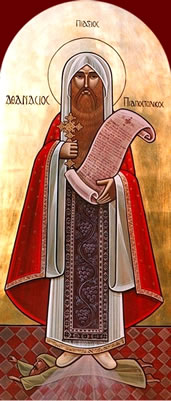Anonymous Church History: 3.7 – The discovery of the holy cross of Christ
3.7.1 She had a burning desire in her heart to visit the holy sites and to search for the Savior’s tomb and the precious wood of the cross of Christ, so she went to Jerusalem.
3.7.2 When she saw the place where he had suffered for universal salvation, she immediately had that foul temple razed to the ground and that cursed soil scattered somewhere far away. When the place which had been hidden had become visible, they saw three buried crosses next to the Lord’s tomb.
3.7.3 They all indisputably believed that one of these was the cross of our Lord and Savior while the others were the crosses of the thieves crucified next to him, but they did not know which one had come close to the Lord’s holy body and caught the stream of his precious blood.
3.7.4 But wise and truly godly Macarius, the head of that church, resolved the uncertainty like so: He recognized the power of the saving cross by observing as the trees were brought before a notable woman of the city who had long been afflicted with disease and was drawing near to death.
3.7.5 While God-loving Helen and a crowd of many people were with him, he knelt in front of the sick woman’s bed and addressed the following prayer to God, crying out in a loud voice: “Lord God Almighty, you worked salvation for the human race through your only-begotten Son Jesus Christ on the tree of the cross. Now in the last times you inspired your servant, together with her son, also your servant, to seek the blessed tree on which Christ, the Savior of all people, especially believers, was crucified in the flesh. So show us, Lord, which of these three trees is the cross of Christ. Through its contact with this sick and half-dead woman, brought about by us, may it become the guide to health and resurrection for her.”
3.7.6 When he had finished praying, he brought the first tree and made it touch the sick woman, but it did not help her at all. Then he brought the second also, but it too proved ineffective. But when he reached for the third, the tree’s shadow immediately approached the sick woman, and a great miracle happened. The half-dead woman suddenly opened her eyes, then, after the Lord’s precious cross had touched her, she jumped up, stood on her feet, and praised God. Having become so much healthier, she walked around the whole house rejoicing and loudly proclaimed the power of the divine cross with the whole household.
3.7.7 Thus the pious empress, the mother of the praiseworthy God-loving Emperor Constantine, simply paid attention and was persuaded concerning the Savior’s tomb and the precious cross of Christ. So she immediately built a house of prayer in that place, as her pious son Constantine had commanded, and called it Martyrium. She advanced further and further in the faith.
3.7.8 Therefore, having finally obtained the object of her desire, she also gave herself over to the search for the nails with which the Lord’s body had been nailed to the tree of the cross. When she had found them, she added some to the emperor’s helmet, showing respect for her son’s head, to deflect the enemies’ arrows. She brought the helmet to her son as a divine gift. She had the remaining nails forged into a bit for the emperor’s horse, bringing about safety for the emperor and fulfilling the ancient prophecy in which the prophet Zechariah long ago shouted, “What is upon the bit will be holy to the Lord Almighty” [Zechariah 14:20].
3.7.9 She apportioned one part of the Savior’s cross to the imperial palace and gave the rest to the bishop of that city, godly Macarius, whom we mentioned above, in a silver container which she had made. She exhorted him to guard the reminders of salvation for future generations.
3.7.10 After she along with Macarius, the head of that church, had gathered craftsmen of every kind from everywhere, as the emperor, her son Constantine, had commanded, she wonderfully built those spacious, magnificent temples. I consider it quite superfluous to describe their beauty and size in this book, seeing as practically all who love Christ, from everywhere under heaven, come together there to see the extravagance of the buildings.
3.7.11 That praiseworthy admirable empress, the mother of the faithful emperor, did another deed worth remembering. She gathered all those who had devoted their lives to virginity, seated them on many couches, and herself did the work of a maidservant: serving them, setting meals before them, giving them cups and pouring wine for them, and carrying the ewer to the basin and pouring water on their hands.
3.7.12 Having done these and similar things, she gladly returned to her son, and not long afterwards she departed to the immortal life, fully content, after enjoining her son at length about pious living and crowning him with parting blessings. Even after her death, therefore, she obtained the honor she deserved as one who had so carefully and vigorously served the God of all.
3.7.13 She was survived by her daughter Constantia, who was the wife of wicked Licinius.
3.7.14 I have included in this historical account these few things about blessed, pious, godly Helen of her many great virtuous deeds for God our Savior.
Next Chapter – 3.8 The godly Constantine’s tribute
Previous Chapter – 3.6 The blessed Helen’s journey to Jerusalem
Click here to read Book 1 in its entirety.
Created by RR 1-17-22
No Responses yet
